Myeloid erythrocyte - Study guides, Class notes & Summaries
Looking for the best study guides, study notes and summaries about Myeloid erythrocyte? On this page you'll find 248 study documents about Myeloid erythrocyte.
Page 2 out of 248 results
Sort by
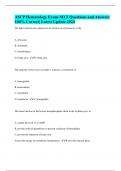
-
ASCP Hematology Exam-MLT Questions and Answers 100% Correct| Latest Update 2024
- Exam (elaborations) • 23 pages • 2024
-
- $10.49
- + learn more
The light-colored zone adjacent to the nucleus in a plasmacyte is the: A. ribosome B. chromatin C. mitochondria D. Golgi area - D. Golgi area The majority of the iron in an adult is found as a constituent of: A. hemoglobin B. hemosiderin C. myoglobin D. transferrin - A. hemoglobin The main function of the hexose monophosphate shunt in the erythrocyte is to: A. reglate the level of 2,3-DPG B. provide reduced glutathione to prevent oxidation of hemoglobin C. prevent the reduction of h...
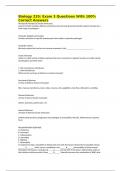
-
BIOL 235 final Exam Questions With 100% Correct Answers
- Exam (elaborations) • 14 pages • 2024
-
- $11.59
- + learn more
BIOL 235 final Exam Questions With 100% Correct Answers Erythrocytes contain the enzyme carbonic anhydrase carbonic anhydrase catalyzes the conversion of metabolically produced C)2 and water into carbonic acid fixed phagocytic macrophages remove most old erythrocytes from circulation Location of fixed phagocytic macrophages narrow capillaries of the spleen Undifferentiated cells called pluripotent stem cells reside in the bone marrow pluripotent stem cells continu...
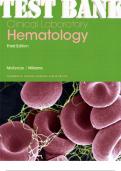
-
TEST BANK for Clinical Laboratory Hematology 3rd Edition by McKenzie Shirlyn & Williams Lynne. ISBN 9780133824438, ISBN-13 978-0133076011 (Chapters 1-42)
- Other • 570 pages • 2024
-
- $26.49
- + learn more
TABLE OF CONTENTS_ Chapter 1: Introduction Chapter 2: Cellular Homeostasis Chapter 3: Structure and Function of Hematopoietic Organs Chapter 4: Hematopoiesis Chapter 5: The Erythrocyte Chapter 6: Hemoglobin Chapter 7: Granulocytes and Monocytes Chapter 8: Lymphocytes Chapter 9: The Platelet Chapter 10: The Complete Blood Count and Peripheral Blood Smear Evaluation Chapter 11: Introduction to Anemia Chapter 12: Anemias of Disordered Iron Metabolism and Heme Synthesis Chapter 13: Hemoglobinopathie...
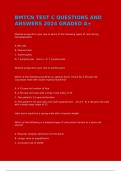
-
BMTCN TEST C QUESTIONS AND ANSWERS 2024 GRADED A+
- Exam (elaborations) • 18 pages • 2024
- Available in package deal
-
- $15.49
- + learn more
BMTCN TEST C QUESTIONS AND ANSWERS 2024 GRADED A+ Myeloid progenitors give rise to which of the following types of cells during hematopoiesis? A. NK cells B. Plasma Cells C. Erythrocytes D. T lymphocytes Ans- D. T lymphocytes Myeloid progenitors give rise to erythrocytes Which of the following would be an optimal donor choice for a 26-year-old Caucasian male with acute myeloid leukemia? A. A 35-year-old mother of four B. A 30-year-old male with a body mass index of 25 C. The ...
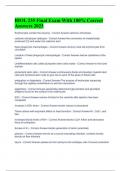
-
BIOL 235 Final Exam With 100% Correct Answers 2023
- Exam (elaborations) • 31 pages • 2023
-
- $14.99
- + learn more
BIOL 235 Final Exam With 100% Correct Answers 2023 Erythrocytes contain the enzyme - Correct Answer-carbonic anhydrase carbonic anhydrase catalyzes - Correct Answer-the conversion of metabolically produced C)2 and water into carbonic acid fixed phagocytic macrophages - Correct Answer-remove most old erythrocytes from circulation Location of fixed phagocytic macrophages - Correct Answer-narrow capillaries of the spleen Undifferentiated cells called pluripotent stem cells reside - C...

-
Immunology Study Questions and Answers 2024 Graded A
- Exam (elaborations) • 69 pages • 2024
-
- $15.49
- + learn more
Examples of pathogens that cause human disease include: a. bacteria b. viruses c. fungi d. parasites (protozoans and worms) e. All of the above - e. All of the above Which of the following is not associated with mucosal surfaces? a. mucus-secreting goblet cells b. lysozyme c. M cells d. beating cilia e. white pulp - e. white pulp One reason that pathogenic microorganisms have an advantage in the host they infect is because they: a. have previously been encountered th...
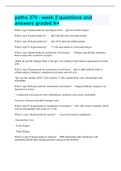
-
patho 370 - week 2 questions and answers graded A+
- Exam (elaborations) • 14 pages • 2023
-
Available in package deal
-
- $27.59
- 1x sold
- + learn more
patho 370 - week 2 questions and answers graded A+ What is type I hypersensitivity and antigen form? IgE and soluble antigen What is type II hypersensitivity? IgG OR IgM and cell-bound antigen What is type III hypersensitivity? IgG AND IgM and soluble antigen What is type IV hypersensitvity? T Cells and soluble or cell-bound antigen What is type I hypersensitivity mechanism of activation? -Allergen-specific IgE antibodies bind to mast cells via their Fc receptor...

-
Blood and Heart Laborda SCF Questions and Answers 100% Verified
- Exam (elaborations) • 7 pages • 2024
- Available in package deal
-
- $7.99
- + learn more
True or False: Scanning electron microscope allows you to see the biconcave disk shape in a 3D dimension. - True Whats the advantage of having a bi concave cell for RBC's? - If we were to shove large shaped erythrocytes would end up in blocking of vessels. So it's better to have them bi concaved and STACKED. Bi-concave disk gives flexibility. They move in stacks in order to allow stopping of clotting. What type of cells stem from a pluripotent stem cell? - Myeloid and Lymphoid stem cells ...
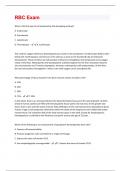
-
RBC EXAM(Graded A+ actual test)
- Exam (elaborations) • 22 pages • 2024
- Available in package deal
-
- $7.99
- + learn more
What is the first type of cell produced by the developing embryo? A. Erythrocyte B. Granulocyte C. Lymphocyte D. Thrombocyte - A. Erythrocyte The need for oxygen delivery to developing tissues results in the production of erythrocytes before other blood cells. Erythropoiesis commences in the yolk sac as early as the fourteenth day of embryonic development. These primitive red cells produce embryonic hemoglobins that temporarily serve oxygen needs of the fetus. Myelopoietic and lymphopoie...
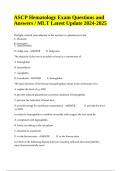
-
ASCP Hematology Exam Questions and Answers / MLT Latest Update 2024-2025.
- Exam (elaborations) • 20 pages • 2024
-
- $12.49
- + learn more
ASCP Hematology Exam Questions and Answers / MLT Latest Update . The light-colored zone adjacent to the nucleus in a plasmacyte is the: A. ribosome B. chromatin C. mitochondria D. Golgi area - ANSWER D. Golgi area The majority of the iron in an adult is found as a constituent of: A. hemoglobin B. hemosiderin C. myoglobin D. transferrin - ANSWER A. hemoglobin The main function of the hexose monophosphate shunt in the erythrocyte is to: A. reglate the level of 2,3-DPG B. provide reduce...

$6.50 for your textbook summary multiplied by 100 fellow students... Do the math: that's a lot of money! Don't be a thief of your own wallet and start uploading yours now. Discover all about earning on Stuvia


